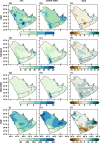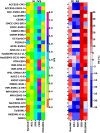Future changes in the precipitation regime over the Arabian Peninsula with special emphasis on UAE: insights from NEX-GDDP CMIP6 model simulations
- PMID: 38168514
- PMCID: PMC10762059
- DOI: 10.1038/s41598-023-49910-8
Future changes in the precipitation regime over the Arabian Peninsula with special emphasis on UAE: insights from NEX-GDDP CMIP6 model simulations
Abstract
Global warming can profoundly influence the mean climate over the Arabian Peninsula, which may significantly influence both natural and human systems. The present study aims to investigate the changes in the precipitation regime in response to climate change over the Arabian Peninsula, with special emphasis on the United Arab Emirates (UAE). This work is performed using a sub-set of high-resolution NASA Earth Exchange Global Daily Downscaled Projections (NEX-GDDP) data derived from Coupled Model Intercomparison Project Phase 6 (CMIP6) Global Climate Models under three different Shared Socioeconomic Pathway (SSP) scenarios (SSP1-2.6, SSP2-4.5, and SSP5-8.5). The changes are analyzed in three phases such as 2021-2050 (near future), 2051-2080 (mid future) and 2080-2100 (far future), with the period of 1985-2014 as the baseline. This study represents the first attempt to utilize data from NEX-GDDP models to project the regional patterns of precipitation regime across the Arabian Peninsula. Results suggest that the annual precipitation is expected to increase over most of the UAE by up to 30%, particularly intense from the mid-future onwards in all scenarios. Specifically, the spatiotemporal distribution of precipitation extremes such as intensity, 1-day highest precipitation, and precipitation exceeding 10 mm days are increasing; in contrast, the consecutive dry days may decrease towards the end of the century. The results show that the changes in extreme precipitation under a warming scenario relative to the historical period indicate progressive wetting across UAE, accompanied by increased heavy precipitation events and reduced dry spell events, particularly under the high emission scenarios. A high-resolution dataset is essential for a better understanding of changes in precipitation patterns, especially in regions where more detailed information is needed on a local scale to achieve water, food security, and environmental sustainability to formulate effective adaptation strategies for mitigating the potential risks and consequences associated with variations in wet and dry conditions.
© 2024. The Author(s).
Conflict of interest statement
The authors declare no competing interests.
Figures

















References
-
- IPCC. (2013). Climate change 2013: The physical science basis. Contribution of working group I to the fifth assessment report of the intergovernmental panel on climate change (In T. F. Stocker, D. Qin, G.-K. Plattner, M. Tignor, S. K. Allen, J. Boschung et al., Eds., pp. 1535). Cambridge University Press.
-
- Clarke B, et al. Extreme weather impacts of climate change: An attribution perspective. Environ. Res. Clim. 2022;1:012001. doi: 10.1088/2752-5295/ac6e7d. - DOI
-
- IPCC et al. Global Warming of 15°C An IPCC Special Report on the impacts of global warming of 15°C Above Pre-Industrial Levels And Related Global Greenhouse Gas Emission Pathways. In: Masson-Delmotte V, Zhai P, Pörtner HO, Roberts D, Skea J, Shukla PR, et al., editors. In the Context Of Strengthening The Global Response To The Threat Of Climate Change, Sustainable Development, And Efforts To Eradicate Poverty. Cambridge University Press; 2018. pp. 3–24.
-
- IPCC et al. Summary for policymakers. In: Masson-Delmotte V, Zhai P, Pirani A, Connors SL, Péan C, Berger S, et al., editors. Climate change 2021: The Physical Science Basis: Contribution of Working Group I to the Sixth Assessment Report of the Intergovernmental Panel on Climate Change. Cambridge University Press; 2021.
-
- Trenberth KE. Changes in precipitation with climate change. Clim. Res. 2011;47:123–138. doi: 10.3354/cr00953. - DOI
LinkOut - more resources
Full Text Sources

